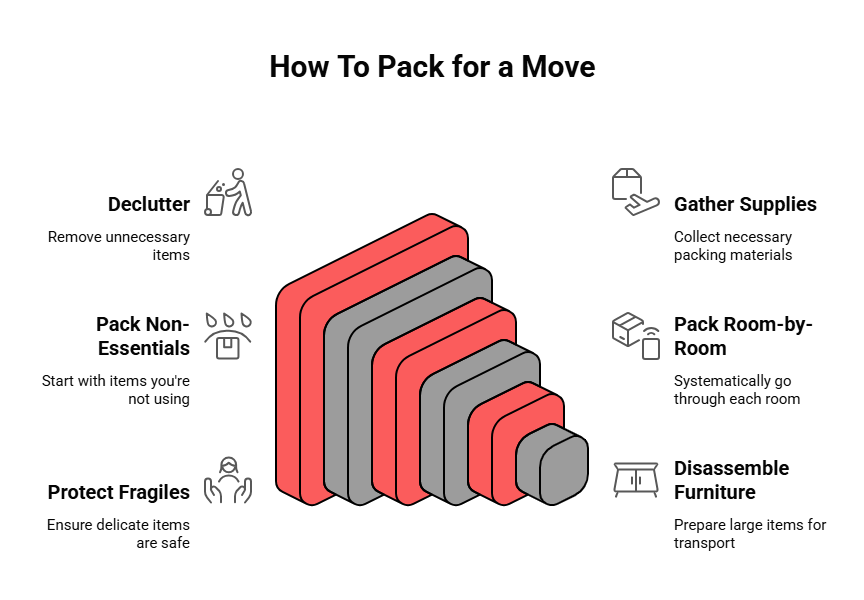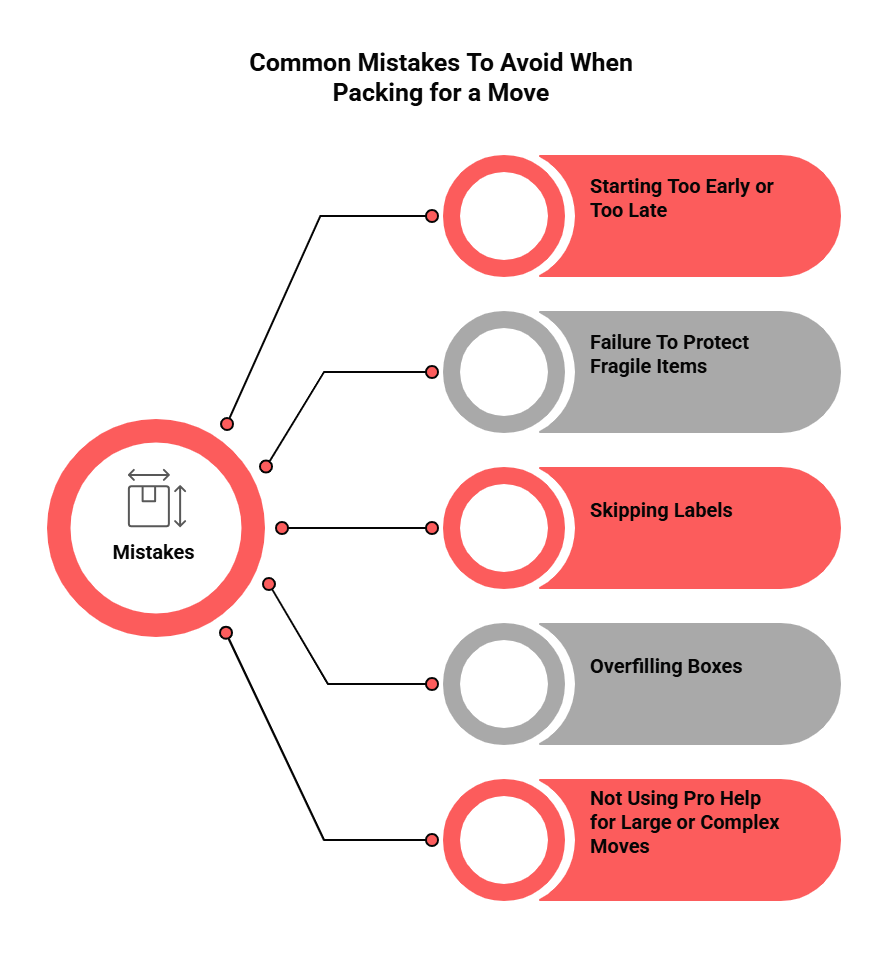How To Pack for a Move: Key Takeaways
- Packing for a move includes a few key steps: decluttering, gathering quality supplies, starting with non-essentials, packing room-by-room, disassembling furniture, and preparing an essentials box
- Start packing four to six weeks before moving day so you have enough time to work through each stage without rushing
- Pack least-used items first: this will help you make progress while keeping daily routines uninterrupted
- Use quality boxes, protective wraps, and specialty supplies to organize and keep your belongings safe
- Avoid common mistakes like overfilling boxes or skipping labels
Did you know that the average American moves nearly 12 times in their lifetime?
Packing for a move can feel like juggling, but instead of balls, you need to balance heavy boxes, tight schedules, and endless to-do lists.
The good news? With the right plan, you can avoid chaos and last-minute stress and even make unpacking a breeze.
This guide will walk you through:
- Step-by-step packing instructions
- When to start packing
- What to pack first
- What to include in your packing supply list
- Common mistakes to avoid
Feeling overwhelmed by packing and tight deadlines? Imperial Movers can help
How To Pack for a Move: A Step-by-Step Guide
A smooth move starts with the right sequence: what comes first and what remains to be packed last minute.
Not following a logical order may lead to losing track of items, damage, and feeling overwhelmed.
1. Declutter Before Packing
Go room by room and make a list of what to keep, donate, sell, or toss.
Be realistic: if you haven’t used something in a year, it’s likely you won’t need it, and it’s not worth the effort or cost to move it.
That treadmill you’re using as a clothes rack? Sell it and save yourself the workout to the fifth floor.
2. Gather Quality Packing Supplies
Cheap materials can lead to broken items or boxes collapsing during transportation.
Make sure you have sturdy boxes, bubble wrap, and furniture blankets, along with permanent markers and Ziploc bags.
3. Start With Non-Essentials
Those dusty holiday lights? They’re first in line for the moving box. Then comes everything you won’t use before you move: seasonal clothing, hobby supplies, and extra kitchen gadgets like mixers or slow cookers.
Useful tip: If you’re unsure about an item, pack it now. You can always dig it out before sealing the box.
4. Pack Room-by-Room
Want to be sure you won’t mix items? Dedicate one or two days per room to pack what’s in it.
Label each box, jotting down what’s inside. Use the color code system, let’s say, blue for kitchen, yellow for bedroom, green for living room.
You’ll be thankful when uploading, as it will speed up unpacking and arranging your new place.
5. Protect Fragile Items
Wrap each glass individually in packing paper, then bundle in bubble wrap. If there are several layers of items, put towels or blankets between them for extra protection.
Pro tip: Instead of blankets, use your clothes and linens (yes, that’ll make your move more sustainable).
Arrange plates standing on edge like records with padding between each, a proven method to ensure safe transit, as per moving pros.
6. Disassemble Furniture and Large Items
Take apart beds, tables, and shelving, attaching screws and hardware in a labeled bag taped directly to the item.
Wrap wooden surfaces with furniture blankets to prevent scratches.
7. Prepare a Box With Essentials
This will be the first box you’ll open at your new home, so it should contain all the things you’ll need on your first night there.
Think toiletries, medications, chargers, basic kitchen utensils, one set of bedding, a change of clothes, snacks, and cleaning supplies.
Make sure you transport the essentials box with you and not on the moving truck. This way, you won’t be hunting for your toothbrush at midnight.

Turn a mountain of boxes into a smooth, organized move
When To Start Packing for a Move
Packing time can vary depending on whether you’re doing it alone, have help from friends, or rely on movers.
If you decide to take care of it on your own, start early so you have enough time to control the process.
- A month before the move: Pack out-of-season clothing, books, and linen you’ll not be using. Start selling or donating items you won’t move.
- Three weeks earlier: Box rarely used kitchen gadgets, small appliances, and extra plates. Do the same with items from attics, basements, and sheds.
- Two weeks before the moving day: Go through closets, guest rooms, and spare bathrooms. Begin disassembling furniture you won’t need until the move.
- One week out: Pack most of your clothing and everyday kitchen items, leaving aside only the things you’ll use. Prepare the essentials box.
- Two-three days before the move: Box daily-use toiletries, remaining kitchen tools, and fridge/freezer items after defrosting.
Here’s a sample timeline: If you’re moving on September 1, start packing mid-July, boxing winter coats and keeping only your summer wardrobe.
What To Pack First When Moving
Want to make progress while keeping daily life normal? Pack from the least-used to most-used.
If you’re moving in the summer, pack your winter coats first. If it’s a winter move, start with the summer sports gear. Find out what’s the best time to move to NYC.
Other things at the top of early packing include:
- Holiday decorations
- Camping gear
- Formal attire
- Decor and artwork
- Photos, paintings, and framed certificates
- Books, games & hobby supplies
- Extra kitchenware
- Spare bedding
Not sure where to start? Professional packers and movers can bring the right materials, pack efficiently, and save you time, stress, and costly mistakes, making them worth every penny.
Essential Packing List for Moving
You maybe know that having the right tools and packing materials is almost like having half of the job done. But what exactly will you need?
Boxes
Prepare boxes of different sizes:
- Small ones for heavy items like books and canned goods
- Medium boxes for kitchenware and electronics
- Large boxes will come in handy for light and bulky items like linen and pillows
Protection Materials
Are boxes enough? Definitely not. Have these ready:
- Bubble wrap and packing paper for fragile items like glass and ceramics
- Foam pouches for plates and mugs
- Furniture blankets and shrink wrap for sofas, tables, and wardrobes
- Permanent markers and color labels to group items per room
- Ziploc bags for screws and bolts
Organizing Tools
Next, you’ll need a few basic items that’ll help you keep your belongings in order and not search for your favorite mug or picture with Granny for months after moving.
A must list includes:
- Permanent markers to label what’s inside each box
- Color labels to assign a color to each room and direct movers where to place the boxes when they arrive at your new place
- Ziploc bags for small hardware
- Stretch wrap for securing drawers and doors of cupboards and large kitchen appliances.
Specialty Items
Need to protect delicate, bulky, or high-value belongings that require extra care? Use a mattress bag to protect it from dust and dirt, wardrobe boxes for hanging clothes, and picture boxes for framed artwork and mirrors.
Common Packing Mistakes To Avoid When Packing for a Move
Even with the best tools and intentions, your moving plans may sometimes go wrong.
- Starting too late can lead to rushed, disorganized packing, ending in chaos and stress.
- Packing too early may leave you without essentials like toiletries, medications, or daily-use kitchenware.
- Overfilling boxes may cause them to break mid-move, causing damage or injuries.
- Skipping labels can result in endless searching, piling wasted time and frustration as you are going through the unmarked boxes.
- Failure to protect fragile items can make glassware and electronics crack or break.
- Not using professional moving services for larger moves or special items can result in damaged furniture, broken valuables, and costly repairs.

From poor timing to skipped labels, these are the mistakes that can make or break your moving day
Why Choose Imperial Movers for Your Packing and Moving
With hundreds of residential and commercial moves over 11 years in business, Imperial Movers is a partner you can trust when it comes to moving to NYC or any of the other states we serve (yes, we work in all 50!).
We offer:
- Full-service packing and unpacking so you can focus on your new home and your loved ones.
- Professional packing supplies like high-quality boxes, wraps, and padding to protect every item, from TVs and pictures to dishes, pianos and pool tables.
- Furniture disassembly/reassembly so you don’t need to ask a friend for a furniture lifter and extra help over the weekend.
- Secure storage solutions, which can be useful when your move-in and move-out dates don’t line up.
Equipped with knowledge of New York’s parking permits, Certificate of Insurance (COI), the right tools, and desire to help, we turn every relocation into a breeze.
Running out of time before moving day? Call Imperial Movers
How To Pack for a Move: FAQs
How soon before moving should I start packing?
Plan to start packing four to six weeks before your move. This will give you enough time to do the job and react if something unexpected comes up.
What should I pack first?
Start with the least-used items:
- Holiday décor
- Books
- Extra bedding
Do I need to wrap my mattress?
Absolutely. Packing your mattress in a bag will protect it against dust, dirt, and moisture, which might put your health at risk.
How do I pack bedding?
Wash, dry, and fold your bedding, then pack it into boxes or vacuum-seal bags. Keep one set aside for the first night in your new home so you don’t need to rummage through the pile of boxes and get stressed.
Should I hire professional packers?
While you may think organizing the move on your own or calling friends to help may be a smart and cost-effective choice, it comes with drawbacks. Trusted pros like our team at Imperial Movers can pack in hours what might take you days, ensuring a fast, safe, and hassle-free relocation.
Worried fragile items won’t make it? Call Imperial Movers




